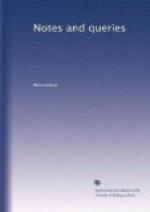“The island was uninhabited when the Portuguese, after having doubled the Cape of Good Hope, discovered it. They gave it the name of Mascarhenas, a cause que leur chef se nommoit ainsi; and the vulgar still preserve it, calling the inhabitants Mascarins. It was not decidedly inhabited until 1654, when M. de Flacour, commandant at Madagascar, sent some invalids there to recover their health, that others followed; and since then it has been named the Isle of Bourbon.”
Still no notice of the Dodo! but
“On y trouve des oiseaux
appelez Flamans, qui excedent la
hauteur d’un grand homme.”
Qu. 6. I know not whether Mr. S. is aware that there is the head of a Dodo in the Royal Museum of Natural History at Copenhagen, which came from the collection of Paludanus? M. Domeny de Rienzi, the compiler of Oceanie, ou cinquieme Partie du Globe (1838, t. iii. p. 384.), tells us, that a Javanese captain gave him part of a Dronte, which he unfortunately lost on being shipwrecked; but he forgot where he said he obtained it.
Qu. 7. Dodo is most probably the name given at first to the bird by the Portuguese; Doudo, in that language, being a fool or lumpish stupid person. And, besides that name, it bore that of Toelpel in German, which has the same signification. The Dod-aers of the Dutch is most probably a vulgar epithet of the Dutch sailors, expressive of its lumpish conformation and inactivity. Our sailors would possibly have substituted heavy-a——. I find the Dodo was also called the Monk-swan of St. Maurice’s Island at the commencement of last century. The word Dronte is apparently neither Portugese nor Spanish, though in Connelly’s Dictionary of the latter language we have—
“Dronte, cierto
paxaro de Indias de alas muy cortas—an
appellation given by some
to the Dodo.”
It seems to me to be connected with Drone; but this can only be ascertained from the period and the people by whom it was applied.
That the bird once existed there can be no doubt, from the notice of Sir Hamon L’Estrange, which there is no reason for questioning; and there seems to be as little reason to suppose that Tradescant’s stuffed specimen was a fabrication. He used to preserve his own specimens; and there could be no motive at that period for a fabrication. I had hoped to have found some notice of it in the Diary of that worthy virtuoso Zacharias Conrad von Uffenbach, who visited the Ashmolean Museum in 1710; but though he notices other natural curiosities, there is no mention of it. This worthy remarks on the slovenly condition and inadequate superintendence of our museums, and especially of that of Gresham College; but those who recollect the state of our great national museum forty years since will not be surprised at this, or at the calamitous destruction of Tradescant’s




